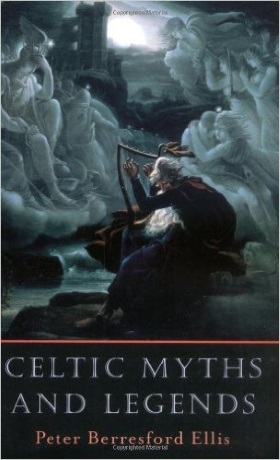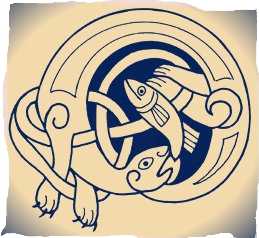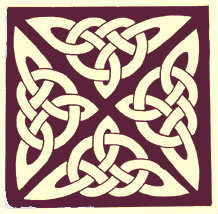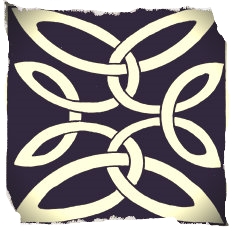Celtic Myths and Legends by Peter Berresford Ellis
 “Celtic Myths and Legends”, by Peter Berresford Ellis, is an entertaining 600 pages of 37 mythic tales drawn from the legends and folklore of the six Celtic nations. This work benefits immensely from the story telling prowess of the author who is also author of the “Sister Fidelma” historical mysteries under his pseudonym of Peter Tremayne.
“Celtic Myths and Legends”, by Peter Berresford Ellis, is an entertaining 600 pages of 37 mythic tales drawn from the legends and folklore of the six Celtic nations. This work benefits immensely from the story telling prowess of the author who is also author of the “Sister Fidelma” historical mysteries under his pseudonym of Peter Tremayne.
In addition to the tales based on folkloric tradition, the author gives the reader a grounding in the Mythology of the Celtic peoples and an overview of the Celtic languages in the 22 page introduction. An introduction which deftly places into context the ancient roots of Celtic mythology and in doing so supports the premise that certain aspects of Celtic Myth are windows to the very beginnings of Indo-European culture. Ellis continues with a concise summary of the linguistic development and divergence of the mother tongue into the two Celtic language groups of Brythonic (Welsh, Breton and Cornish) versus that of the Goidelic (Irish, Scottish and Manx).
Linguists argue that the form of Celtic we term Goidelic is the more archaic branch of Celtic. It is suggested that around the 7th century BC, the Celtic languages subdivided, when the form which we call Brythonic emerged. From a Goidelic parent, Brythonic modified and evolved in several ways.
Placing Celtic culture and language in its historical context is almost an art form with Ellis:
The mythology, legends and folklore of the Celtic peoples are among the most vibrant of Europe. The Celts were, in fact, the first European people north of the Alps to emerge into recorded history. They were delineated from their fellow Europeans by virtue of the languages which they spoke and which we now identify by the term Celtic.
It is Ireland, the only modern Celtic nation that did not suffer at the hands of the Romans that led the resurgence of Celtic literature after the collapse the Empire in the 5th century. Citing research by Harvard Professor Calvin Watkins, the Author gives the following quote: “Irish became the third literary language of Europe, after Greek and Latin”.
There is a precision to the organisation and presentation of these entertaining tales based on the author’s scholarly knowledge of the Celtic Pantheon and the historical context in which the tales are placed; firstly by the work’s general introduction and secondly by the preface for each of the Six Nations in which there is a discussion of the history of the language and development of the literary heritage of Cornwall, Brittany, Scotland, The Isle of Man, Wales & Ireland.
 This reviewer’s favourite entry is the “Pan Celtic” tale which appears after the introduction and prior to the six chapters devoted to each of the Six Nation’s folklore. I was mesmerised by this tale of the creation of the Celtic gods, the writer’s craft creating a brilliant image as if from the Celtic equivalent of the Old Testament: “From the darkened soil there grew a tree, tall and strong. Danu, the divine waters from heaven, nurtured and cherished this great tree which became the sacred Oak named Bile. Of the conjugation of Danu and Bile, there dropped two giant acorns. The first acorn was male. From it sprang The Dagda, “The Good God”. The second seed was female. From it there emerged Brigid, “The Exalted One”. And The Dagda and Brigid gazed upon one another in wonder, for it was their task to wrest order from the primal chaos and to people the Earth with the Children of Danu, the Mother Goddess, whose divine waters had given them life”. Perhaps not the inspired word of God, but this one paragraph is a beguiling amalgamation of the creation of the rulers of the Celtic Pantheon. Dagda, the chief God of the Celts, the majestic Brigid who was worshiped throughout the Celtic lands, and Bile, whose role was transporting the souls of dead Celts to the Otherworld. Also included are the children of the Mother Goddess Danu, the Tuatha de Danann, who are fundamental to Scottish, Irish and Manx Mythology.
This reviewer’s favourite entry is the “Pan Celtic” tale which appears after the introduction and prior to the six chapters devoted to each of the Six Nation’s folklore. I was mesmerised by this tale of the creation of the Celtic gods, the writer’s craft creating a brilliant image as if from the Celtic equivalent of the Old Testament: “From the darkened soil there grew a tree, tall and strong. Danu, the divine waters from heaven, nurtured and cherished this great tree which became the sacred Oak named Bile. Of the conjugation of Danu and Bile, there dropped two giant acorns. The first acorn was male. From it sprang The Dagda, “The Good God”. The second seed was female. From it there emerged Brigid, “The Exalted One”. And The Dagda and Brigid gazed upon one another in wonder, for it was their task to wrest order from the primal chaos and to people the Earth with the Children of Danu, the Mother Goddess, whose divine waters had given them life”. Perhaps not the inspired word of God, but this one paragraph is a beguiling amalgamation of the creation of the rulers of the Celtic Pantheon. Dagda, the chief God of the Celts, the majestic Brigid who was worshiped throughout the Celtic lands, and Bile, whose role was transporting the souls of dead Celts to the Otherworld. Also included are the children of the Mother Goddess Danu, the Tuatha de Danann, who are fundamental to Scottish, Irish and Manx Mythology.
 “Celtic Myths and Legends”, by Peter Berresford Ellis, is an entertaining 600 pages of 37 mythic tales drawn from the legends and folklore of the six Celtic nations. This work benefits immensely from the story telling prowess of the author who is also author of the “Sister Fidelma” historical mysteries under his pseudonym of Peter Tremayne.
“Celtic Myths and Legends”, by Peter Berresford Ellis, is an entertaining 600 pages of 37 mythic tales drawn from the legends and folklore of the six Celtic nations. This work benefits immensely from the story telling prowess of the author who is also author of the “Sister Fidelma” historical mysteries under his pseudonym of Peter Tremayne.
The section on Brittany has a tale entitled “Koadalan” which comes to us from the 19th century Breton oral tradition. A tale of deceit and duplicity, the story tells of a poor peasant boy, named Koadalan, who tricks a mysterious nobleman. The nobleman makes the boy his servant and the boy steals three red-leather bound books of knowledge which give the boy the immense powers of a magician. He angers the Gods because of his deceit and the books are seized by them and are lost forever. Koaladen is then banished to the Otherworld where he is consigned to search forever for the lost knowledge contained in the books. He emerges from the Otherworld only one day each year at Samhain:
That night, my friends, is called the eve of Gouel an Anaon, All Souls Day, which is known in other parts of the world as Halloween. So if you have any red leather-bound books, on that dark evening, do not be surprised to see them spin in the air and then fall to the ground, nor start at the sound of a wailing cry. It is just Koaladen, searching for his lost magic books, which he is now doomed to do for ever and a day.
 Amongst the other tales in this wonderful book we find entertaining adaptations of the various folkloric traditions. From the Goidelic, we have the Irish tale of “The Children of Lyr” who were orphaned and bewitched into swans that lived for 900 years, a tale that is one of the “Three Sorrows of Ireland.” From Scotland a tale based on the legend of the Kelpie, spirits lurking in the stormy seas who appear as Blue Men or fearsome Water Horses and who lure unsuspecting victims to watery graves. The Brythonic tales of Wales and Cornwall give us the Welsh tale of “Bran & Branwen” based on the legend of Bran the Blessed and his sister Branwen who was married to the King of Ireland and suffered a calamitous fate. And from Cornwall the tale of “Jowan Chy-an-Horth”, based on the only folktale surviving in the Cornish tongue.
Amongst the other tales in this wonderful book we find entertaining adaptations of the various folkloric traditions. From the Goidelic, we have the Irish tale of “The Children of Lyr” who were orphaned and bewitched into swans that lived for 900 years, a tale that is one of the “Three Sorrows of Ireland.” From Scotland a tale based on the legend of the Kelpie, spirits lurking in the stormy seas who appear as Blue Men or fearsome Water Horses and who lure unsuspecting victims to watery graves. The Brythonic tales of Wales and Cornwall give us the Welsh tale of “Bran & Branwen” based on the legend of Bran the Blessed and his sister Branwen who was married to the King of Ireland and suffered a calamitous fate. And from Cornwall the tale of “Jowan Chy-an-Horth”, based on the only folktale surviving in the Cornish tongue.
The Manx tale “Island of the Ocean God” is expertly woven around the myths of Ogma, son of Dagda, known as the Irish God of eloquence and literature, and the fate of his son Mac Cuill. Mac Cuill is slain by invaders of Ireland but because he is a God, grandson to the supreme Dagda, his spirit lived on through reincarnation until his series of rebirth ended with him as a lowly criminal. He was condemned under Brehon law and put out to sea chained to his boat and cast away from shore. The Sea God Manannan took pity on him and caused him to land on the Isle of Man where he rose to be Saint Maughold (The Patron Saint of The Isle of Man). This tale, as much as any other, demonstrates how expert were the Christian missionaries in weaving Celtic myth into Christian belief making it seem as if the new religion was really an extension of the existing faith in the Gods of the Celtic Pantheon.
The Mammoth Book of Celtic Myths and Legends, by Peter Beresford Ellis, was first published as “The Chronicles of The Celts” in 1999. This work reflects the author’s storytelling skills which brings to life the legends of all the Celtic traditions helping to preserve an important element of our culture for generations to come. We at Transceltic recommend this work. Those with an interest in Celtic culture should have this book in your library. These tales deserve to be read and re-read for many years to come.
Celtic Myths and Legends by Peter Berresford Ellis
Get your copy from Amazon.com (US$) or Amazon.co.uk (GB£):
Content type:
- Pan-Celtic
Language:
- English
- Log in to post comments






